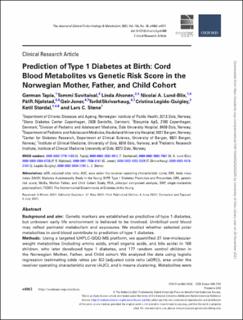Prediction of type 1 diabetes at birth: Cord blood metabolites vs genetic risk score in the Norwegian mother, father, and child cohort
Tapia, German; Suvitaival, Tommi; Ahonen, Linda; Lund-Blix, Nicolai Andre; Njølstad, Pål Rasmus; Joner, Geir; Skrivarhaug, Torild; Legido-Quigley, Cristina; Størdal, Ketil; Stene, Lars Christian Mørch
Journal article, Peer reviewed
Published version

Åpne
Permanent lenke
https://hdl.handle.net/11250/2832040Utgivelsesdato
2021Metadata
Vis full innførselSamlinger
- Department of Clinical Science [2318]
- Registrations from Cristin [9791]
Originalversjon
Journal of Clinical Endocrinology and Metabolism (JCEM). 2021, 106 (10), e4062-e4071. 10.1210/clinem/dgab400Sammendrag
Background and aim: Genetic markers are established as predictive of type 1 diabetes, but unknown early life environment is believed to be involved. Umbilical cord blood may reflect perinatal metabolism and exposures. We studied whether selected polar metabolites in cord blood contribute to prediction of type 1 diabetes.
Methods: Using a targeted UHPLC-QQQ-MS platform, we quantified 27 low-molecular-weight metabolites (including amino acids, small organic acids, and bile acids) in 166 children, who later developed type 1 diabetes, and 177 random control children in the Norwegian Mother, Father, and Child cohort. We analyzed the data using logistic regression (estimating odds ratios per SD [adjusted odds ratio (aOR)]), area under the receiver operating characteristic curve (AUC), and k-means clustering. Metabolites were compared to a genetic risk score based on 51 established non-HLA single-nucleotide polymorphisms, and a 4-category HLA risk group.
Results: The strongest associations for metabolites were aminoadipic acid (aOR = 1.23; 95% CI, 0.97-1.55), indoxyl sulfate (aOR = 1.15; 95% CI, 0.87-1.51), and tryptophan (aOR = 0.84; 95% CI, 0.65-1.10), with other aORs close to 1.0, and none significantly associated with type 1 diabetes. K-means clustering identified 6 clusters, none of which were associated with type 1 diabetes. Cross-validated AUC showed no predictive value of metabolites (AUC 0.49), whereas the non-HLA genetic risk score AUC was 0.56 and the HLA risk group AUC was 0.78.
Conclusions: In this large study, we found no support of a predictive role of cord blood concentrations of selected bile acids and other small polar metabolites in the development of type 1 diabetes.
